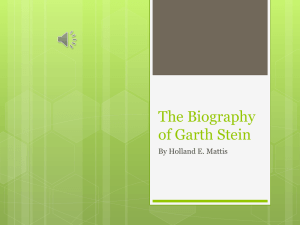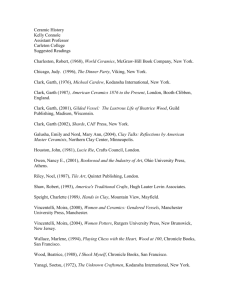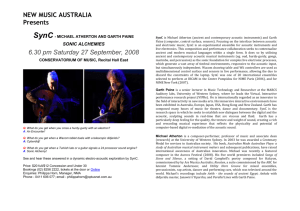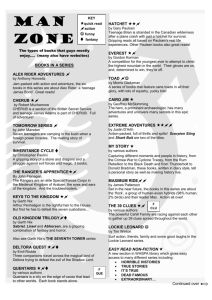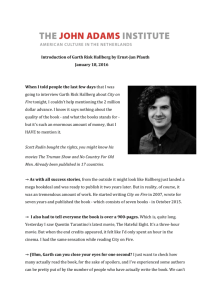historic survey of garth`s addition, columbia, boone county, missouri
advertisement
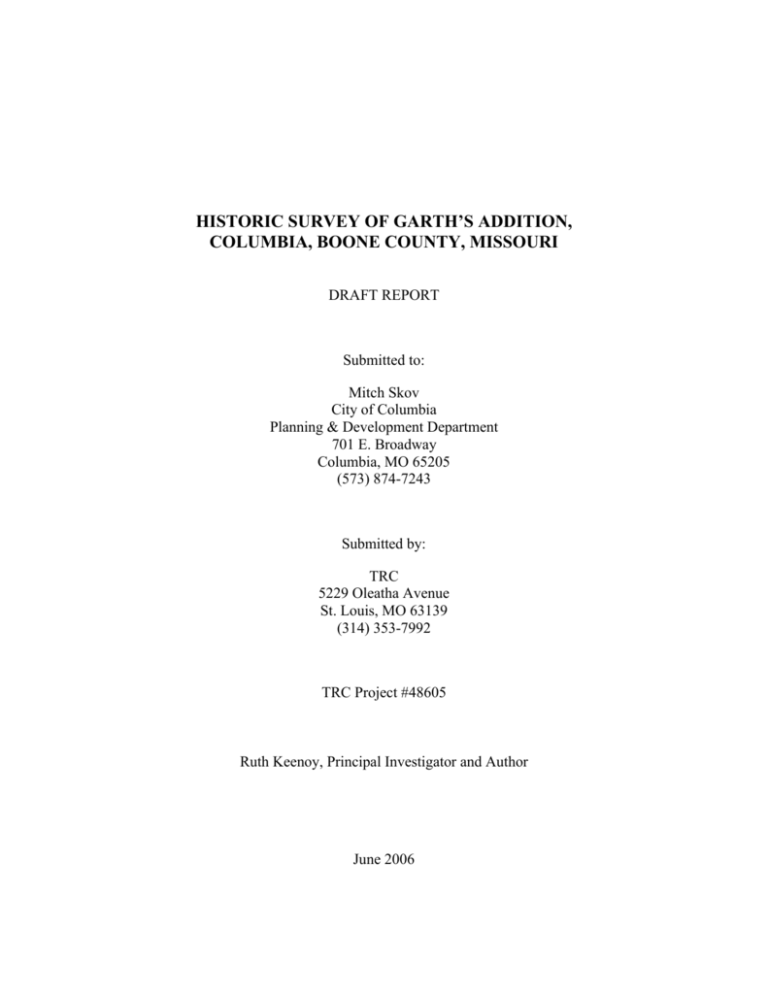
HISTORIC SURVEY OF GARTH’S ADDITION, COLUMBIA, BOONE COUNTY, MISSOURI DRAFT REPORT Submitted to: Mitch Skov City of Columbia Planning & Development Department 701 E. Broadway Columbia, MO 65205 (573) 874-7243 Submitted by: TRC 5229 Oleatha Avenue St. Louis, MO 63139 (314) 353-7992 TRC Project #48605 Ruth Keenoy, Principal Investigator and Author June 2006 MANAGEMENT SUMMARY In October 2005, TRC contracted with the City of Columbia to complete the survey of a neighborhood near downtown Columbia commonly known as “Garth’s Addition.” The study area is bordered to the east by McBaine Avenue, to the north by West Ash Street, to the west by West Boulevard, and to the south by West Broadway. A total of 241 properties were recorded during the course of the survey, which was conducted in 2005– 2006 by Ruth Keenoy of TRC, St. Louis, Missouri. It is the opinion of TRC that the inventoried neighborhood retains high potential as a historic residential district eligible for the National Register of Historic Places under Criterion C (architecture). The neighborhood features a large number of early twentiethcentury housing that, to a large degree, retains its architectural integrity. The neighborhood contains examples of Craftsman-style dwellings, such as Bungalows and Tudor-Revival housing; Ranch style dwellings; American Foursquare homes, and Queen Anne, Colonial Revival, and Dutch Revival housing. There is also evidence of recent modifications to the neighborhood, including loss and/or replacement of some original housing, modification of single-family homes for use as multi-family housing, and renovation of existing properties that has compromised the architectural integrity of these homes. The degree of such alterations is minimal, however, and at this point in time does not appear to diminish the integrity of the neighborhood as a historic district. A complete discussion of the survey findings, recommendations, history of the neighborhood and architectural context for the potential district is provided within this report. Questions regarding the contents of this document should be directed to Ruth Keenoy at (314) 353-7992. Survey of Garth’s Addition, Columbia, Boone County, Missouri ii ACKNOWLEDGMENTS TRC would like to thank persons involved in the management and administration of the project, particularly Mitch Skov with the City of Columbia’s Planning and Development Department. Ruth Keenoy served as the project manager for the survey, assisted by Todd Cleveland, who completed review and administration of the final documents. Vince Macek provided graphics support in production of the survey forms, supplemental data, and the survey report. Larissa Thomas completed the editing and final production of the project data. Last, but not least, TRC would like to thank all of the residents of the Garth’s Addition neighborhood for their kindness and generosity; particularly Angela Belden and Christiane Quinn, who shared historic photographs and personal research about their neighborhood. Survey of Garth’s Addition, Columbia, Boone County, Missouri iii CONTENTS MANAGEMENT SUMMARY ..........................................................................................................ii ACKNOWLEDGMENTS..................................................................................................................iii FIGURES ............................................................................................................................................ v INTRODUCTION............................................................................................................................... 1 SURVEY METHODOLOGY............................................................................................................. 1 HISTORICAL OVERVIEW OF THE SURVEYED AREA.............................................................. 1 ARCHITECUTRAL CONTEXT FOR THE SURVEYED AREA OF GARTH’S ADDITION ....... 7 NATIONAL REGISTER OF HISTORIC PLACES – REQUIREMENTS AND REGISTRATION – DISTRICTS...................................................................................................... 13 INTEGRITY ISSUES ....................................................................................................................... 17 RECOMMENDATIONS .................................................................................................................. 21 REFERENCES.................................................................................................................................. 22 APPENDIX A – MAPS OF GARTH’S ADDITION APPENDIX B – QUESTIONNAIRES RETURNED BY PROPERTY OWNERS Survey of Garth’s Addition, Columbia, Boone County, Missouri iv FIGURES 1. Map illustrating the surveyed (study) area of Garth’s Addition, Columbia, Missouri, 2005– 2006......................................................................................................................................... 2 2. Map of original Garth’s Addition boundaries within the city of Columbia, date unknown. ....... 4 3. 1917 plat map of the Garth’s Addition neighborhood (surveyed area)........................................ 6 4. 115 Anderson Avenue is a typical example of a gable-front plan Bungalow seen throughout the Garth’s Addition neighborhood......................................................................................... 8 5. 9 McBaine Avenue is a fine example of a larger Craftsman-style home typically seen in the Garth’s Addition neighborhood............................................................................................... 8 6. 106 Bicknell Street is an example of a modest Tudor Revival-style home. ................................ 9 7. 119 Meadow Lane is another example of the Tudor Revival-style housing found in Garth’s Addition................................................................................................................................... 9 8. 116 West Boulevard is an example of a brick-clad, Minimal Traditional-style dwelling. ........ 11 9. The property at 109 Meadow Lane is one of many Ranch-style homes within the western half of the Garth’s Addition neighborhood. .......................................................................... 11 10. The dwelling at 703 W. Broadway features characteristics of the Queen Anne style of architecture. ........................................................................................................................... 12 11. Anderson Avenue features at least two examples of Dutch Revival-style homes at 19 (top) and 21 Anderson (bottom)..................................................................................................... 14 12. 709 W. Broadway is an example of an American Foursquare dwelling in the Garth’s Addition neighborhood.......................................................................................................... 15 13. Streetscape view of Aldeah Avenue, Garth’s Addition; view is northwest. ............................ 15 14. Streetscape view of Anderson Avenue, Garth’s Addition; view is southwest......................... 16 15. Historic view of 413–415 Walnut Street, ca. 1940 (photo provided courtesy of Angela Belden, 413 Walnut Street). .................................................................................................. 18 16. Current view of 413–415 Walnut Street (2005)....................................................................... 18 17. Meadow Lane features an open meadow at the end of the street. Features such as this are historic and should be retained to stabilize the integrity of the neighborhood...................... 20 18. 713 W. Broadway is an example of a property that has been either replaced by new construction or altered to the point that it no longer retains its historic integrity.................. 20 Survey of Garth’s Addition, Columbia, Boone County, Missouri v INTRODUCTION The Columbia–Garth’s Addition historic neighborhood inventory was conducted between October 2005 and March 2006. A total of 241 properties within the boundaries of the surveyed area were documented. Of these properties, at least 14 have lost their integrity due to extensive modifications, or are less than 50 years of age and fail to contribute to the historic character of the neighborhood. The study area includes only a portion of what is locally known as “Garth’s Addition,” bordered to the north by West Ash Street, to the west by West Boulevard, to the south by West Broadway, and to the east by McBaine Avenue (Figure 1). The purpose of the inventory was to identify whether the neighborhood is eligible for the National Register of Historic Places (NRHP) as a historic district. Based on the types of housing within the study area, most of which were constructed between the years 1925–1955, it is the opinion of TRC that the neighborhood appears eligible for the NRHP under Criterion C as a good example of an early residential, middle class suburb associated with the early twentieth-century growth and development of Columbia, Missouri. SURVEY METHODOLOGY The architectural inventory for Garth’s Addition near downtown Columbia was completed using guidelines provided by the Historic Preservation Division of the Missouri Department of Natural Resources and the National Park Service’s National Register Bulletin 24: Guidelines for Local Surveys: a Basis for Preservation Planning (rev. 1985). Survey information, including field notes, sketch maps, photographs, and Missouri Historic Resources Inventory Forms, was maintained throughout the architectural inventory. Each inventoried property was photographed utilizing 35mm black-and-white film. Color slide film was used to photograph unique features of the neighborhood and streetscapes. City parcel maps provided by the Boone County Tax Assessor’s office were utilized to plot locations of the inventoried properties. Copies of the completed inventory forms were provided to the City of Columbia, along with sketches of each property site, at least one 5 × 7-inch black and white photograph of each inventoried property, and property tax maps. Ownership information was provided by the Boone County Tax Assessor Office’s database and by residential interviews. HISTORICAL OVERVIEW OF THE SURVEYED AREA The area surveyed by TRC in 2005–2006 is an early- to mid-twentieth-century residential neighborhood bordered at the north by West Ash Street, at the west by West Boulevard, at the south by West Broadway, and at the east by McBaine Avenue (see Figure 1). Located just west of downtown Columbia, the area remained rural in appearance even after the turn of the twentieth century. The original boundaries for what was recognized Survey of Garth’s Addition, Columbia, Boone County, Missouri 1 Survey of Garth’s Addition, Columbia, Boone County, Missouri 2 Figure 1. Map illustrating the surveyed (study) area of Garth’s Addition, Columbia, Missouri, 2005–2006. as “Garth’s Addition” during the late nineteenth century were roughly North Boulevard at the north, Garth Avenue at the east, Broadway at the south, and present-day West Boulevard at the west (Figure 2). Garth’s Addition was named for Jefferson Garth, who obtained the parcel in 1836 from William Jewell. Jewell gained ownership through a federal patent issued in 1829 (“Abstract of Title” provided by C. Quinn: Boone County Warranty Deed, Book G, Page 381; Boone County Patents, Book C, Page 49). Jefferson Garth was born in Scott County, Kentucky, in 1803 to John and Sally (Griffith) Garth. He moved to Boone County, Missouri, in 1836 with his parents and his wife, Mary Ann Russell. By the late 1840s, Jefferson and Mary Ann had eight children—seven sons and one daughter. Two sons died prior to reaching adulthood. In 1882, Jefferson and Mary Ann’s children were as follows: William, a farmer living in Clay County, Missouri; Samuel, a cattle rancher living in “the Indian Nation”; Henry H. a grocer in Rocheport, Missouri; James M., a farmer living near Rocheport; and Lizzie Worley of Columbia. Jefferson Garth’s farm encompassed approximately 600 acres that by the early 1880s was situated “partially within the suburbs of Columbia” (History of Boone County, 1882:868– 69). This parcel became what is today known as “Garth’s Addition.” A large portion of Jefferson Garth’s farm was inherited by his youngest son, W.W. (Walter Warren) Garth, who retained a large section of the family farm when the area was subdivided during the early 1900s. W.W. Garth was born in Columbia in 1848 and, like his father, was a prominent citizen of Boone County. He attended Columbia State University and two early colleges in Columbia administrated by the Baptist and Christian congregations. At the age of 18, W.W. was appointed deputy circuit clerk, a position he held until he was elected county circuit clerk and recorder at the age of 26. In 1867, W.W. married Eva Samuel of Kentucky. The couple had six children, including John, Mary, Jefferson, Lucy, and William. One child (unnamed) died very young. John died in 1881 at the age of 13. W.W. was active as a Mason and a member of the Presbyterian Church (History of Boone County, 1882:868). W.T. (William Thomas) Anderson was another early landowner associated with the Garth’s Addition neighborhood. The city plat map from 1917 indicates that at the time, Anderson owned a large parcel bordered by Ash (on the north), Broadway (on the south), a parcel owned by H.D. Murry and C.R. Noel (on the east), and a parcel owned by William Hirth (on the west) (Ogle, 1917:10). Anderson was an original owner of the Columbia Milling Company, incorporated in 1882 (History of Boone County, 1882:813). Anderson’s parents moved to Boone County, Missouri, from Virginia. He was born in Howard County in 1842 and completed a degree from Missouri State University (Columbia). He married Bettie Baker in 1868, and the couple had three children: Dorsey, Clifford, and James P. Anderson worked as co-owner of a grocery, known as Anderson, Garth, & Co., from 1862 to 1869. After this, he worked as owner and operator of Columbia Mills, where his primary duties related to selling and buying grain. Anderson also held several “municipal positions” during his lifetime (Ibid:832). In the late nineteenth century, his property holdings were described as “a nice farm of 143 acres, and residence, one mile north of town, on the Mexico road” (Ibid). Survey of Garth’s Addition, Columbia, Boone County, Missouri 3 Figure 2. Map of original Garth’s Addition boundaries within the city of Columbia, date unknown. Survey of Garth’s Addition, Columbia, Boone County, Missouri 4 Based on a 1917 plat map of the surveyed area (Figure 3), the Garth’s Addition neighborhood had been further subdivided by that time and encompassed the following subdivisions, all of which were formerly part of the larger Garth’s Addition: McBaine’s Western Addition, Wise’s Subdivision, W.W. Payne’s Addition, and the Broadway Subdivision. A portion of the area was also still called Garth’s Addition, which remains true to this day. By 1917, approximately half of the surveyed area was subdivided into smaller lots for individual housing, consistent with the current character of the neighborhood. The streets of Bicknell, Walnut, and Meadow Lane were all in place by 1917, although Meadow Lane is not identified by name on the plat map. The western portion of the surveyed area consisted of much larger parcels in 1917, all of which were within present-day Garth’s Addition and bordered on the east by the Broadway Subdivision. This area encompassed parcels owned by C.R. Noel, H.D. Murry, James Gordan, W.T. Anderson, William Hirth, Duncan Mitchell, E.J. Blellock, Maud Weathers, P.J. Mitchell, and L.L. Terrell. These large parcels stretched between Ash and Broadway. No individual streets had been planned or constructed by 1917 to divide the area bounded at the north by Ash, at the west by West Boulevard, at the south by Broadway, and at the east by Glenwood. Bordering the east side of West Boulevard were three large parcels owned by George L. Williams, F.E. Jacobs, and L.A. Snead. Walnut Court, Anderson, and Greenwood streets did not exist in 1917 (Ogle, 1917:10). Sanborn Fire Insurance maps dating to 1925 indicate that by that time, much of the neighborhood’s housing was established as far west as Bicknell Street, although houses along Bicknell and Walnut were not yet constructed. Aldeah and McBaine avenues appeared much as they do today, with small, single-family homes, and larger homes were located along West Broadway (Sanborn Fire Insurance Company, 1925). The development of the neighborhood during the 1920s is further illustrated by the city directory published in 1926, in which McBaine Avenue supported at least 20 residents. Aldeah Avenue supported three residents, Ash (west of McBaine and east of West Boulevard) supported six residents, and West Broadway supported 18 residents. Bicknell Street at that time had two residents listed in the city directory, Glenwood had ten residents, Anderson Street had five residents, Walnut Street had four residents, and West Boulevard had only one resident listed (Heber Page Directory Co., 1925–26). A history of the city written during the late 1930s/early 1940s states that north of Broadway, the “city changes character. Here the streets are lined with small frame houses occupied by industrial and low-salaried white collar workers” (Works Progress Administration, 1941:208). Although this may be somewhat true for the Garth’s Addition area, this description more likely illustrates the neighborhood east of Garth Street near downtown. The construction of homes in the vicinity of Garth’s Addition was strongly middle-class in character. After World War II, this became even more pronounced when housing at the west end of the surveyed area was constructed. It is this area of the neighborhood that former resident, Abbey Bonham, who lived at 104 West Boulevard during the 1960s, says included a dentist, the owner of Neats Department Store in downtown Columbia, and owners of a local nursery. Bonham’s father, Wilfred “Peewee” Survey of Garth’s Addition, Columbia, Boone County, Missouri 5 Figure 3. 1917 plat map of the Garth’s Addition neighborhood (surveyed area). Survey of Garth’s Addition, Columbia, Boone County, Missouri 6 Shock, built their family home around 1950, at which time West Boulevard marked the city’s western limits (Interview, Abbey Bonham, 10 November 2005). ARCHITECUTRAL CONTEXT FOR THE SURVEYED AREA OF GARTH’S ADDITION The project area is comprised primarily of houses that reflect early twentieth-century styles such as Craftsman, Tudor Revival, and Ranch—the three most prominently featured property types within the neighborhood. In lesser numbers are examples of Queen Anne, Colonial Revival, Dutch Revival, and American Foursquare homes. The Craftsman/Bungalow dwelling was widely popular in America from around 1905 through the late 1930s. The American Arts-and-Craft movement, which spurred development of the Bungalow, began as an outgrowth of Victorian-era England’s movement introduced by architects, designers, and craftsmen. Inspired by designer William Morris and social critic John Ruskin, the Arts-and-Crafts movement protested industrialism and encouraged local workmanship (Cumming and Kaplan, 1991:9–12). One of the most significant contributors to the early American movement was Gustav Stickley of Syracuse, New York. Stickley, well known as a furniture maker, published The Craftsman journal from 1901–1916, which emphasized unpretentious form and functionality in architecture and design (Wright, 1981:162–163). Also prominent in the early American Arts-and-Crafts movement was the Pasadena, California, architectural firm of Greene & Greene, established by brothers Charles Sumner Greene and Henry Greene in 1893. The Greenes received early training in a crafts background while attending Calvin Milton Woodword’s Manual Training High School in St. Louis (Missouri) (Cumming and Kaplan, 1991:122; Wayman, [1981]: Schools). The California Bungalow, which epitomizes the Greenes’ residential designs, features an “open interior, one-storey plan, wrap-around porch and low-pitched, overhanging roof [offering] ventilation and protection. [Its] rapid assembly, affordability and informality” made it particularly suitable for the California climate (Cumming and Kaplan, 1991:123). Overall, the Bungalow is the most representative form of housing within the study area of Garth’s Addition (Figure 4). Most examples are not overwhelmingly large, but are small cottage-style, gable-front plan, brick homes that feature prominent primary porches supported by tapered piers and/or brick and stucco posts. There are also numerous examples of the larger Craftsman-style Bungalow that is most commonly associated with California styles of the Bungalow (Figure 5). These homes, many of which are located on Anderson and Greenwood avenues, feature large overhanging eaves, wide open porches, sloping rooflines, and multi-pane/colorful glass above doors and windows. All of these types of Craftsman homes within the Garth’s Addition neighborhood are noteworthy, and those that have not been extensively altered strongly contribute to the historic character of the neighborhood. As noted, there are also many examples of Tudor Revival-style homes in the Garth’s Addition neighborhood (Figures 6–7). The Tudor Revival style of architecture was Survey of Garth’s Addition, Columbia, Boone County, Missouri 7 Figure 4. 115 Anderson Avenue is a typical example of a gable-front plan Bungalow seen throughout the Garth’s Addition neighborhood. Figure 5. 9 McBaine Avenue is a fine example of a larger Craftsman-style home typically seen in the Garth’s Addition neighborhood. Survey of Garth’s Addition, Columbia, Boone County, Missouri 8 Figure 6. 106 Bicknell Street is an example of a modest Tudor Revival-style home. Figure 7. 119 Meadow Lane is another example of the Tudor Revival-style housing found in Garth’s Addition. Survey of Garth’s Addition, Columbia, Boone County, Missouri 9 another prominent form of housing in middle-class America during the early-to-mid twentieth century, particularly during the 1930s and early 1940s in the case of Garth’s Addition. Typical features of Tudor Revival-style homes include half timbers in the gable fields, exterior finishes such as concrete and stucco, multi-sash leaded casement windows, large exterior brick or stone chimneys, arched windows, and vertical plank doors (Carley, 1994:200–201). Predecessors of the style were buildings dating to eighteenth- and nineteenth-century England that featured solid masonry construction. Following the Columbian Exposition in 1893, this style was popularized in America through the introduction of balloon frame construction, which was most affordable. Brick and stone veneer provided exterior adornment that imitated grand European styles but did not limit such designs to only the wealthy (McAlester and McAlester, 1990:319). There are many examples of transitional housing featuring Minimal Traditional influences, as well as classic Ranch-style homes, in the Garth’s Addition neighborhood (Figures 8–9). These later types illustrate the growth and development that occurred throughout the 1940s–1960s, by which time the neighborhood was fully established as a residential district. Popular after 1940, Minimal Traditional-style homes are a “compromise style which reflects the form of” Craftsman and Tudor Revival styles but “lacks their decorative detailing” (McAlester and McAlester, 1990:478). These types of homes often feature large, primary façade exterior chimneys reminiscent of the Tudor Revival style. Most are frame construction with exterior shingles or weatherboard; however, Garth’s Addition also features examples with exterior brick walls. Minimal Traditional homes feature a steeper pitched roof than Ranch houses, although not nearly as steep as Tudor Revival houses. Ranch dwellings in contrast feature low pitched rooflines, more reminiscent of Craftsman styles, along with large, picture-style windows and often attached garage wings. The Ranch home replaced the Bungalow as the most common form of twentieth-century housing in America after World War II (McAlester and McAlester, 1990:479). Most examples of Minimal Traditional and Ranch homes in Garth’s Addition are situated west of Aldeah Avenue, as this area was developed, for the most part, later than the eastern half of the neighborhood. There are very few examples of Queen Anne-style homes in Garth’s Addition; however, such examples are noteworthy (Figure 10). The Queen Anne style is a late-nineteenthcentury architectural gem named for Queen Victoria’s reign in England, which lasted until after the turn of the twentieth century. Rapid industrial growth and development spurred the style’s popularity as, for the first time, builders gained access to inexpensive and machine-made materials such as milled wood, balloon frames, and factory-produced nails, glass, and metal. The railroad quickly transported materials to local markets, and architectural journals provided standardized plans that became widely available to almost everyone in America (McAlester and McAlester, 1990:239). Queen Anne-style homes normally feature heavy architectural embellishments, such as decorative millwork, wraparound porches, turrets, stained glass lights, patterned masonry, and ornamental gable and porch details. Also in Garth’s Addition are several examples of Colonial Revival and Dutch Revivalstyle homes. During the late nineteenth and early twentieth centuries, Colonial Revival Survey of Garth’s Addition, Columbia, Boone County, Missouri 10 Figure 8. 116 West Boulevard is an example of a brick-clad, Minimal Traditional-style dwelling. Figure 9. The property at 109 Meadow Lane is one of many Ranch-style homes within the western half of the Garth’s Addition neighborhood. Survey of Garth’s Addition, Columbia, Boone County, Missouri 11 Figure 10. The dwelling at 703 W. Broadway features characteristics of the Queen Anne style of architecture. Survey of Garth’s Addition, Columbia, Boone County, Missouri 12 architecture was very popular in residential construction. Less ornate than Queen Anne, the style incorporated classical elements of Greek, Federal, and Italian influences, with emphasis on symmetrically placed doors and windows. Entrances to Colonial Revival homes usually incorporate classical surrounds with pediments, columned porches, and sidelights/transoms. Features of the house often include gabled dormers and Palladian windows. Dutch Colonial homes were also popular in the early twentieth century (Figure 11). The most prominent feature of this type of home is its gambrel roof. Entrances are often similar to Colonial Revival and Craftsman-style homes, featuring either a classical surround or Craftsman-style doors and porches. One additional early-twentieth-century residential style featured in Garth’s Addition is the American Foursquare (Figure 12). This type of home is so named for its unmistakably square plan. It is normally a two-and-one-half-story house resting on a solid foundation, such as stone or brick. It features a hip roof and hipped roofline dormers—usually one at each elevation. The porch is prominently featured, either centrally or as a wraparound element (Thornton, This Old House website). Figures 13 and 14 offer streetscape views along Aldeah and Anderson avenues, showing the existing housing and yards and their relationship to one another and the street corridors as a whole. NATIONAL REGISTER OF HISTORIC PLACES – REQUIREMENTS AND REGISTRATION – DISTRICTS The National Register of Historic Places is a national inventory of historic properties. The NRHP includes buildings, structures, objects, sites, and districts that retain integrity of location, design, setting, materials, workmanship, feeling, and association, and also meet at least one of the criteria outlined below. Criterion D is most often (but not exclusively) associated with archaeological resources. • Criterion A (Event). Association with one or more events that have made a significant contribution to the broad patterns of national, state, or local history. • Criterion B (Person). Association with the lives of persons significant in the past. • Criterion C (Design/Construction). Embodiment of distinctive characteristics of a type, period, or method of construction; or representation of the work of a master builder or architect; possession of high artistic values; or representation of a significant and distinguishable entity whose components may lack individual distinction. • Criterion D (Information Potential). Properties that yield (or are likely to yield) information important in prehistory or history. The neighborhood associated with Garth’s Addition is one that appears to have high potential as an NRHP district under Criterion C: Architecture. Survey of Garth’s Addition, Columbia, Boone County, Missouri 13 Figure 11. Anderson Avenue features at least two examples of Dutch Revival-style homes at 19 (top) and 21 Anderson (bottom). Survey of Garth’s Addition, Columbia, Boone County, Missouri 14 Figure 12. 709 W. Broadway is an example of an American Foursquare dwelling in the Garth’s Addition neighborhood. Figure 13. Streetscape view of Aldeah Avenue, Garth’s Addition; view is northwest. Survey of Garth’s Addition, Columbia, Boone County, Missouri 15 Figure 14. Streetscape view of Anderson Avenue, Garth’s Addition; view is southwest. Survey of Garth’s Addition, Columbia, Boone County, Missouri 16 For any property to be eligible for the NRHP, it must retain integrity. In the case of the Garth’s Addition neighborhood, not all of the houses retain integrity; however, because the collection of housing is being evaluated as a district, the level of integrity applies to the entire neighborhood as a whole, rather than to individual houses. Integrity is defined by seven factors, which are as follows: • Location. The place where the property was constructed. • Design. The elements that create the form, plan, space, structure and style of the house. • Setting. The historic environment (i.e., the yard and surrounding neighborhood plan) that is associated with the house. • Materials. The physical features of the house that illustrate its methods and style of construction. • Workmanship. Physical evidence of the house’s construction that illustrates its period of construction and the people who lived and/or built the home. • Feeling. The property’s expression or historic sense of its place/time of construction and use. • Association. A direct link between the property, its period of significance, and the person(s) associated with its historic use. It is the opinion of TRC that the Garth’s Addition neighborhood meets the seven aspects of integrity as outlined above. All of the historic homes (those at least 50 years of age) are in their original locations and illustrate their historic environment. Although some examples have been altered since their original construction, most have not been so altered to the point that they no longer illustrate their historic period of significance (Figures 15–16). Some houses feature modern siding. Although such changes are discouraged, this does not mean that every house with modern siding is a noncontributing feature of the district; in fact, most still contribute to the character of the district. Most homes illustrate original workmanship and provide a “feeling” or a “sense of time and place” associated with the neighborhood’s early years of development. INTEGRITY ISSUES As noted, some houses within Garth’s Addition do not retain their historic exterior materials. Others have had modifications, such as additions, or have been converted from single-family to multi-family units. Such modifications often intrude upon the historic character of the neighborhood. At this point in time, it does not appear that these alterations are extensive; therefore, the neighborhood continues to reflect its historic period of construction and use. However, it is important to realize that the continuation of improvements, renovations, and/or actions such as demolition and new construction have the potential to diminish the integrity of the neighborhood to the point that it will no Survey of Garth’s Addition, Columbia, Boone County, Missouri 17 Figure 15. Historic view of 413–415 Walnut Street, ca. 1940 (photo provided courtesy of Angela Belden, 413 Walnut Street). Figure 16. Current view of 413–415 Walnut Street (2005). Survey of Garth’s Addition, Columbia, Boone County, Missouri 18 longer be eligible for the NRHP. In addition to the housing, the neighborhood’s communal spaces, such as the meadow at the end of Meadow Lane, are significant spaces and should be retained (Figure 17). Properties that currently fail to retain their integrity and thus contribute to the historic character of the district are as follows: 114 Aldeah Avenue 109 McBaine Avenue 111 McBaine Avenue 23 N. Greenwood Avenue 410 W. Walnut Street 101 Bicknell Street 104 Bicknell Street 118 Bicknell Street 7–9 N. Glenwood Avenue 10 N. Glenwood Avenue 307 W. Broadway 713 W. Broadway (Figure 18) 12 Anderson Avenue 20 Anderson Avenue It is recommended that if homeowners wish to improve their properties without destruction of historic integrity, they should adhere to the Secretary of the Interior’s Standards for Rehabilitation. In short, any changes to the historic fabric of a house should be made only if necessary. For modifications such as window replacement, siding replacement, porch reconstruction, etc., new materials should imitate the existing or historic fabric as much as possible. These guidelines are available on-line at http://www.cr.nps.gov/hps/tps/tax/rhb/. For additional information and technical assistance, homeowners should access the Missouri Historic Preservation Office, Department of Natural Resources website for Technical Assistance at http://www.dnr.mo.gov/shpo/techasst.htm. Survey of Garth’s Addition, Columbia, Boone County, Missouri 19 Figure 17. Meadow Lane features an open meadow at the end of the street. Features such as this are historic and should be retained to stabilize the integrity of the neighborhood. Figure 18. 713 W. Broadway is an example of a property that has been either replaced by new construction or altered to the point that it no longer retains its historic integrity. Survey of Garth’s Addition, Columbia, Boone County, Missouri 20 RECOMMENDATIONS Recommendations for the City of Columbia at this point in time are as follows: • Determine whether there is sufficient interest in the Garth’s Addition neighborhood to complete a National Register Nomination Form for a historic district. It appears that there is high potential for an NRHP-eligible district associated with the surveyed area of Garth’s Addition. The photographs and inventory forms, along with this report, provide sufficient information for the Missouri Department of Natural Resources/Historic Preservation Division to make a preliminary determination regarding TRC’s eligibility recommendations. However, prior to proceeding with NRHP listing, it is recommended that a survey of neighborhood residents be conducted to determine whether property owners would be agreeable to having their properties listed in the NRHP. A majority of property owners must agree to the listing; otherwise, it will not pass the state’s review process. • If there is sufficient interest to pursue the NRHP district nomination, hire a qualified historic preservation consultant approved by the State Historic Preservation Office to complete the nomination form. The intention of the survey has been to provide sufficient information to determine whether or not there is a historic district associated with Garth’s Addition. The survey does not provide sufficient information, however, to complete a National Register nomination. Additional research and investigation will be required to complete a nomination. Moreover, the district’s boundaries must be coordinated with the Missouri State Historic Preservation Office. Engaging the services of an individual or firm that meets the Secretary of the Interior’s Professional Qualifications Standards best serves the needs of the community and will ensure that the NRHP nomination process goes as smoothly as possible. It is important to note that properties will not qualify for historic tax credits (state or federal) unless they are listed in the NRHP. Therefore, if the intent of the neighborhood is to gain tax credits, residents must list their homes as an NRHP historic district. The next step for tax credit purposes is to nominate the neighborhood as an NRHP district, provided that a majority of property owners agrees to such a step. For more information regarding the NRHP process or for a list of qualified consultants approved by the State of Missouri, contact Tiffany Patterson at the Missouri State Historic Preservation Office, (573) 751-7800. Jo Ann Radetic serves as the state’s Certified Local Government Coordinator; her number is (573) 522-2473. Samantha Berhorst assists with information concerning grant applications and tax credits. She may be reached at (573) 751-5376. Survey of Garth’s Addition, Columbia, Boone County, Missouri 21 REFERENCES “Abstract of Title for Subdivision of Lot #15, Garth’s Addition.” Copies of historic documents (deeds, trust information, etc.) provided by Christiane Quinn, 719 W. Broadway, Columbia, MO. Boham, Abbey. Telephone interview with Ruth Keenoy, 10 November 2005, regarding Bonham’s family home at 104 West Boulevard, Columbia, MO. Carley, Rachel. The Visual Dictionary of American Domestic Architecture. New York: Henry Holt and Company, 1994. Cumming, Elizabeth, and Wendy Kaplan. The Arts and Crafts Movement. London: Thames & Hudson, 1991. Heber Page Directory Co. Columbia Missouri City Directory, 1925–26. Springfield, MO: C.B. Page Directory Company, 1926. [no author] History of Boone County, Missouri, written and compiled from the most authentic official and private sources; including a history of its Townships, Towns, and Villages … St. Louis: Western Historical Co., 1882. McAlester, Virginia and Lee McAlester. A Field Guide to American Houses. New York: Alfred A. Knopf, 1990. Ogle, George A. & Co. Standard Atlas of Boone County, Missouri. Chicago: Selfpublished, 1917. Sanborn Fire Insurance Company. Maps of Columbia, MO, from ca. 1901 to ca. 1986 (Reel 1). Available on microfiche at Missouri Historical Society/Newspaper Library, Columbia, MO. Published by the Sanborn Map Company, New York. Thornton, Rosemary. “The American Foursquare, 1890–1930s.” Article in This Old House On-line: http://www.oldhouseweb.com/stories/Detailed/12269.shtml. Access date 27 May 2006. Wayman, Norbury. History of St. Louis Neighborhoods: Oak Hill and Morganford. St. Louis: St. Louis Community Development Agency [1981]. Workers of the Writers’ Program of the Works Progress Administration. Missouri: The WPA Guide to the “Show Me” State. St. Louis: Missouri Historical Society Press, 1998 (reprint). Original version published in 1941 by the Missouri State Highway Department. Wright, Gwendolyn. Building the Dream: A Social History of Housing in America. Cambridge, MA: The MIT Press, 1981. Survey of Garth’s Addition, Columbia, Boone County, Missouri 22 APPENDIX A – MAPS OF GARTH’S ADDITION APPENDIX B - QUESTIONNAIRES RETURNED BY PROPERTY OWNERS
